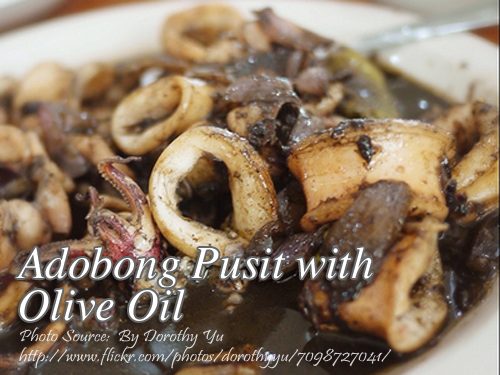Adobong pusit is a well known Filipino dish that consist of sliced squid stewed in soy sauce, vinegar, spices and tomatoes but this recipe I have here does not have soy sauce instead, it is added with calamansi juice and olive oil. This is tastier and savory adobong pusit with olive oil version that you must try. Cleaning the squid takes a bit of work because you have to remove the ink sac, innards, beak and the transparent back bone. Usually squid have a transparent film like backbone unlike cuttlefish that have a bony boat shaped, white color, chalky and brittle backbone called cuttlebone.
Adobong Pusit with Olive Oil: A Family Twist on a Classic Favorite
When my Uncle Dodong came back from a long fishing trip in Cavite, he brought with him a bucket full of fresh squid, still gleaming and slippery in the early morning light. I remember my Aunt Lorna calling me over, apron already tied, as she cleaned the squid with practiced hands. “We’re not doing soy sauce today,” she said, handing me a calamansi to slice. “We’re making your uncle’s favorite—adobong pusit with olive oil.”
I had never tried adobong pusit like that before. No soy sauce? But once I had a bite, I understood why it was a staple every time Uncle Dodong came home. This version is brighter, lighter, and more aromatic than the usual deep, salty adobo. The olive oil and calamansi give it a savory, slightly tangy flavor that lingers beautifully.
Why This Adobong Pusit Version Works
The absence of soy sauce might raise eyebrows, but trust me, it’s not a loss—it’s an upgrade. Calamansi juice gives just the right acidity without overwhelming the dish. Combined with vinegar, it balances the squid’s natural brininess. Olive oil, on the other hand, adds depth and smoothness, mellowing the sharpness of the vinegar. It also helps carry the flavor of the garlic and tomatoes, coating every bite of squid in richness.
Using olive oil instead of the usual cooking oil is one of those small tweaks that makes a big difference. Olive oil’s fruity notes blend well with seafood, enhancing its sweetness. My cousin Maricel, who studied culinary arts in Cebu, once told me that olive oil creates a more velvety finish when used in slow-simmered dishes like this.
The Secret is in the Ink and Tomatoes
I used to think squid ink was just a fancy ingredient in pasta, but my Aunt Lorna showed me otherwise. When gently sautéed with garlic and simmered with tomatoes, the ink deepens the flavor, giving the sauce a subtle richness without tasting fishy. The tomatoes, softened slowly over low heat, lend a natural sweetness that rounds out the dish.
Be patient with the simmering. Those 15 minutes with the tomatoes allow them to break down and marry with the ink, creating a sauce that’s almost silky. Adding a bit of water and letting it reduce just slightly thickens it enough to coat rice perfectly.
Cleaning the Squid—Don’t Skip This Part
If this is your first time handling squid, don’t worry. It might look intimidating, but once you know what to look for, it’s a breeze. Remove the ink sac carefully—you’ll want that later. The transparent spine, which looks like a piece of plastic, slides out easily. Wash the body gently but don’t scrub out the fat inside; that’s flavor you’ll want to keep. Slice the squid into bite-sized rings and you’re good to go.
My brother Emil, who always finds the cleaning part gross, insists it’s worth it when the dish hits the table. And he’s right.
A Little History Behind Adobong Pusit
Adobo, in all its variations, is deeply Filipino. While chicken and pork adobo are the most popular, coastal communities have always used what was abundant—and that meant seafood. Adobong pusit, traditionally cooked with soy sauce and vinegar, became a quick and flavorful way to preserve fresh squid.
This olive oil version may not be what our lolas grew up making, but it’s still very Filipino—adapting, experimenting, and always finding ways to make the most of what we have. I like to think of it as the evolution of a classic, shaped by travel, personal taste, and what’s in season.
Best Enjoyed with Rice and Stories
Adobong pusit with olive oil is the kind of dish that fills the kitchen with a rich, garlicky aroma and brings everyone to the table. It’s best eaten hot, over steamed rice, with family members passing around plates and stories.
That first time I made it on my own, I remembered every step my aunt showed me. And when I served it to my friends, they couldn’t believe something so simple could taste that good. “It’s all about timing and good squid,” I said, repeating my aunt’s words like a mantra.
So if you’re in the mood to try something different but still comforting, this dish is a great place to start. It’s beginner-friendly, but the results are anything but basic. Try it once, and you might just find yourself making it the next time you spot fresh squid at the market.
Who knows—it might become your family’s new favorite too.
How to Cook Adobong Pusit with Olive Oil
Ingredients
- 1/2 kilo fresh squid pusit
- 2 heads garlic crushed
- 1/4 cup white vinegar
- 2 tbsp. lemon or lime juice or calamansi juce
- 1/2 cup water
- 2 tsp. salt
- 1 pc onion chopped
- 2 Tbsp. olive oil
- 1/2 cup chopped fresh tomatoes
- 1 pc long green chili siling mahaba
- 1/2 cup water
- 1/2 tsp. MSG or granulated seasoning
Instructions
How to cook Adobong Pusit with Olive Oil
- Clean squid, remove carefully and set aside ink sacs, pull out and discard spine or cuttlebone.
- Wash the cavity but do not remove the fat. Then slice squid crosswise into 1 inch rings.
- In a saucepan, combine 1 head garlic, vinegar, calamansi juice, water and salt.
- Bring to a slow simmer, then add squid and simmer for 15 minutes. Set aside.
- Sauté onions and remaining garlic in oil until garlic is light brown, then add ink sacks, simmer for 5 minutes.
- Add tomatoes and simmer for 15 minutes.
- Add water and chili, and simmer for 5 minutes.
- Add squid, and simmer for another 5 minutes.
- Adjust seasoning. Serve hot with rice.
Notes
Cooking Tips:
Don’t Overcook the Squid
Squid cooks very quickly—just a few minutes too long and it turns rubbery. For this recipe, keep the simmering time short and controlled, especially after adding the squid. Tender, perfectly cooked squid should be slightly firm to the bite, not chewy.Use Fresh Calamansi Juice, Not Bottled
Fresh calamansi gives the dish a bright, citrusy flavor that bottled versions can't match. Bottled juice often contains preservatives that alter the taste and acidity. Squeeze the juice right before cooking for the most vibrant and balanced flavor.Simmer the Tomatoes and Ink for a Richer Sauce
Take your time letting the tomatoes and squid ink simmer together—this builds depth and complexity in the sauce. The slow cooking breaks down the tomatoes and blends them smoothly with the ink. You’ll get a darker, thicker sauce that clings beautifully to every bite.





